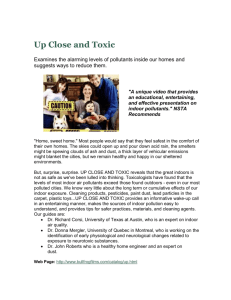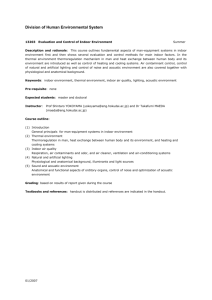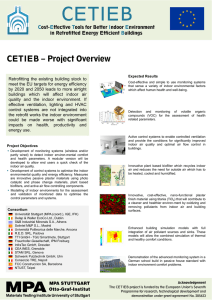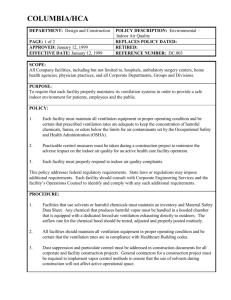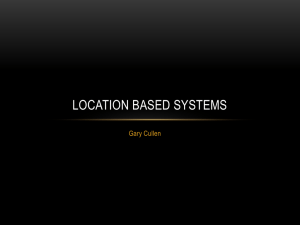analysis of topics and trends in indoor environment research in europe
advertisement
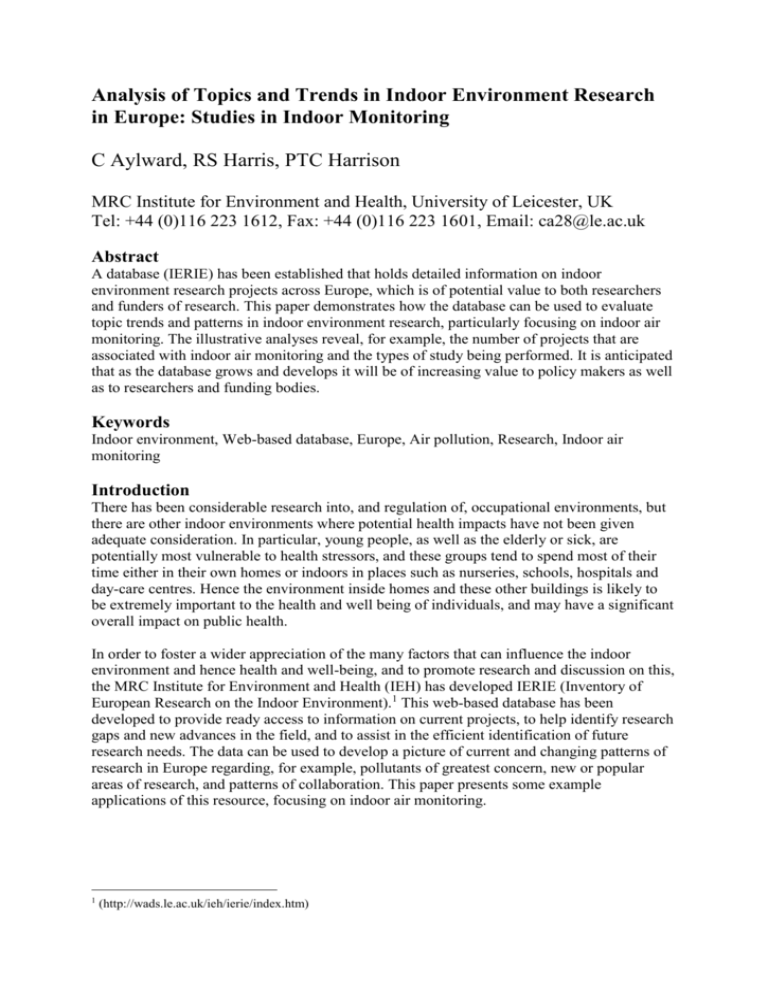
Analysis of Topics and Trends in Indoor Environment Research in Europe: Studies in Indoor Monitoring C Aylward, RS Harris, PTC Harrison MRC Institute for Environment and Health, University of Leicester, UK Tel: +44 (0)116 223 1612, Fax: +44 (0)116 223 1601, Email: ca28@le.ac.uk Abstract A database (IERIE) has been established that holds detailed information on indoor environment research projects across Europe, which is of potential value to both researchers and funders of research. This paper demonstrates how the database can be used to evaluate topic trends and patterns in indoor environment research, particularly focusing on indoor air monitoring. The illustrative analyses reveal, for example, the number of projects that are associated with indoor air monitoring and the types of study being performed. It is anticipated that as the database grows and develops it will be of increasing value to policy makers as well as to researchers and funding bodies. Keywords Indoor environment, Web-based database, Europe, Air pollution, Research, Indoor air monitoring Introduction There has been considerable research into, and regulation of, occupational environments, but there are other indoor environments where potential health impacts have not been given adequate consideration. In particular, young people, as well as the elderly or sick, are potentially most vulnerable to health stressors, and these groups tend to spend most of their time either in their own homes or indoors in places such as nurseries, schools, hospitals and day-care centres. Hence the environment inside homes and these other buildings is likely to be extremely important to the health and well being of individuals, and may have a significant overall impact on public health. In order to foster a wider appreciation of the many factors that can influence the indoor environment and hence health and well-being, and to promote research and discussion on this, the MRC Institute for Environment and Health (IEH) has developed IERIE (Inventory of European Research on the Indoor Environment).1 This web-based database has been developed to provide ready access to information on current projects, to help identify research gaps and new advances in the field, and to assist in the efficient identification of future research needs. The data can be used to develop a picture of current and changing patterns of research in Europe regarding, for example, pollutants of greatest concern, new or popular areas of research, and patterns of collaboration. This paper presents some example applications of this resource, focusing on indoor air monitoring. 1 (http://wads.le.ac.uk/ieh/ierie/index.htm) Method Compiling the database Information to populate the databases is obtained from questionnaires sent directly to researchers across Europe who are working in the indoor environment field. This includes individuals specialising in a variety of scientific disciplines, from ventilation system engineering through to molecular toxicology. Researchers are contacted via organisations such as government bodies, universities and research institutes, or via indirect means such as societies and committees, scientific journals, newsgroups, conference/workshop delegate lists and use of Internet search engines. The questionnaire is specifically designed to obtain information about the researcher’s projects, the sources of funding, and the project collaborators. Data is entered onto a Microsoft SQL Server 7 database through a Microsoft Access 2000 project interface. Details are checked to maintain accuracy and consistency through programming logic and manual inspection. The database is updated on a regular basis. Projects are key-worded using a specially designated three level hierarchical thesaurus so as to allow a user to easily search the database using the predefined terminology (see Figure 1). Figure 1. Example of thesaurus tree structure for term ‘Asthma’ The IERIE website was created using Active Server Pages technology to allow free public access to the database. Users are able to browse details of researchers, their organisations and their projects. Interrogating the database is conducted either using the thesaurus or by entering terms in a search tool based on the project keywords, title and abstract. Analysing the data This paper illustrates the capability of IERIE by analysing some extracted data on the following three topics: Asthma – selected as a disease endpoint. Particulates – selected as an important indoor air pollutant. Volatile Organic Compounds (VOCs) These three topics are specific keyword entries in the IERIE thesaurus. The database is then interrogated using Views (a graphical user interface tool) through the Access 2000 data entry system. For each topic a View can be constructed containing two types of searches: All projects that have been indexed with the appropriate topic keyword (e.g. all project titles that have been indexed with the keyword of ‘asthma’). Any instance of the keyword in the project titles or abstracts (e.g. all projects that contain the word ‘asthma’ in the project title or the project abstract). Once the queries have been run, a selection of top-level keywords from the thesaurus can be chosen to cross-reference against the results with the aim of highlighting any trends in the data. For example, projects associated with asthma that are also indexed with the ‘monitoring’ keyword, can be selected (i.e. a union join query). Based on this criteria further views can be created to produce more detailed information on other themes linked to this association, for instance the countries involved in these projects, or the amount of funding received for them. Results Project breakdown by pollutant type and studies relevant to indoor monitoring Of the 56 projects on the database that are associated with the monitoring of pollutants, 46% (26) involve the study of particulates, 26% are on VOCs, 5% are on odours, 16% are on allergens and 11% are personal monitoring studies (see Figure 2). Of the 180 projects on the database, 17% are associated with indoor modelling, 27% are associated with exposure assessment studies and 50% are linked with chemical/physical phenomena (see Figure 3). Odours 3 Personal monitoring 7 Allergens 9 VOCs 15 Particulates 26 0 5 10 15 20 25 30 Figure 2. Number of Studies Involving Monitoring Pollutants 30 Indoor modelling Exposure assessment studies 49 Chemical/Physical aspects 90 0 20 40 60 80 100 Figure 3. Other Studies Associated with Monitoring Analysis of particular study themes linked to monitoring Asthma A total of 8 projects on the database involve the study of asthma linked with indoor monitoring, looking at aspects of cleaning, carpets and central heating linked with buildings. Half of them are substantially sized projects receiving funding of £50,000 or more, half of the studies are being conducted in Scandinavian countries with the remainder mainly in the UK. Particulates A total of 26 projects on the database involve the study of particulates linked with indoor monitoring, looking at aspects mainly to do with filtration /ventilation and heating systems linked to buildings. Some of the studies concern the elderly. There is a 50/50 mix of projects receiving funding of greater than or less than £50,000. Half of the projects are being conducted in the UK, with a quarter of them in Scandinavia and the rest in northern or eastern Europe. Volatile Organic Compounds (VOCs) A total of 15 projects on the database involve the study of VOCs linked with indoor monitoring, looking at aspects of filters, refurbishment, paint and adhesives linked to buildings. About a quarter of them are substantially sized projects, but the majority receive funding of £50,000 or less. The countries conducting these studies are mainly UK and Finland, but other countries involved are Belgium, France, Germany, Greece, Poland, Slovakia, Estonia, Sweden and Switzerland. Discussion In addition to the identification of current projects and details of researchers working in the indoor environment field, an important application of the IERIE database is in establishing patterns and trends in current indoor environment research. By way of illustration, this paper has demonstrated, amongst other things, the current interest in monitoring particulates and the degree of UK and Scandinavian interest this attracts, the high level of funding of asthma studies that include indoor air monitoring and the significant wide interest in monitoring VOCs. The effectiveness and reliability of IERIE rests on the data it contains being complete, correct and up-to-date. The system currently established ensures that the data are current and reliable – the important next step is to ensure the benefits and applications of the database are widely known, and to promote the capture of more and more projects that are ongoing across Europe. It will then be possible to undertake further pattern analysis, including, for example, trends over time and a more robust analysis of the distribution of different kinds of study amongst the countries of Europe. Conclusions and Implications IERIE is a useful tool to identify current research on the indoor environment and workers in the field and to evaluate current and changing trends in component topic areas. The analysis of extracted data in this paper has provided a useful and practical example of the potential use of the database to evaluate key research themes. In time IERIE will become the primary centralised source of indoor environment project information in Europe, and will be of increasing value to policy makers as well as researchers and funders of research. Acknowledgements This work was supported by research funding from the CEFIC Long-range Research Initiative. Special thanks are due to Dr Chris Money of CEFIC and to all the researchers who have supplied information for inclusion on the IERIE database.

